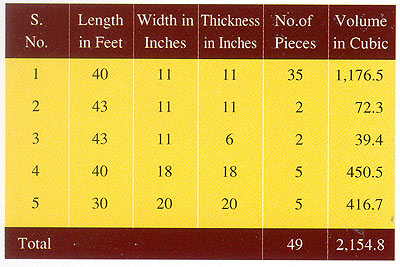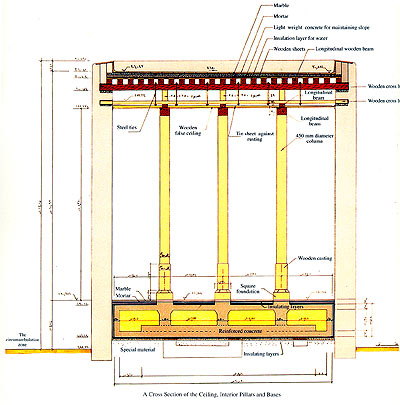>
The Selection of Trees
Teak trees grow in the forests of India and Burma. The forests of Nilimbour and Rangoon in Burma were visited with the sole purpose of examining the available trees. It was determined that the requirements for the ceiling of the Holy Ka'bah might be obtained easily from the forests of Burma. Saudi Bin Ladin Group appointed some representatives for co ordination with specialized Burmese firms through the Ministry of Forests in Burma. They were authorized to select suitable trees, supervise cutting them, taking them to the lathe, choosing the best of them, and shipping them to the Kingdom of Saudi Arabia. The search for specific teak trees in Burma went into the forests of Bayo, Kana and Mediek regions 1000 kilometres away from the capital. The area studied amounted to 13.000 donums. The best trees were in forests 250 kilometres from Rangoon.
One hundred and thirty seven trees were selected, cut and transported to the lathe but only 49 pieces were chosen according to the following table

Steps Taken in Preparing the Timber
These pieces were shipped to Jeddah where they remained for six months to dry in a relatively natural atmosphere. They were then placed in an especially adjusted drying oven. In the case of the large size pieces, humidity was reduced to 15%. Although teak wood resists white ants and fungi, for more protection the wood was treated with the protective coating of Boracol. This material is non toxic, colourless and odourless. Rust proof iron bands were wrapped around the upper edges of the girders and pillars that form the load points and supports. Soft wood pieces were discarded.
The Design
All parts of the ceiling and pillars were chosen to resemble previous specifications. Pillars were placed at equal distances in order to distribute the loads on the walls and inner pillars evenly.
The Works of Insulation and Marble
A layer of insulating materials was laid on the wooden ceiling, then a thin concrete layer was laid over it. Gutters that drain water from the roof were secured. The whole roof and its edges were then covered with marble.
The Waterspout
The old waterspout was replaced with a new one of the same dimensions. It was stronger, more solid and more beautiful than the previous one.
The Bases of the Pillars
The old rocky bases were replaced with reinforced concrete and the pillar bases were also encased in concrete to protect them from the effects of humidity. Concrete was also poured from the base to the level of the floor of the Holy Ka'bah to relieve pressure from the walls.

A cross section of the ceiling. Interior pillars and bases.
|
